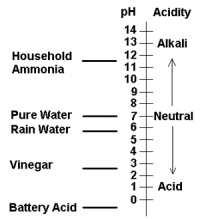Over the years, I
have heard lime credited with doing a lot of things
from eliminating grubs to curing fungal diseases. As
far as I know, adding lime to your soil does only
two things. It adds calcium to the soil and, in the
process, raises the
pH number i.e. makes the soil
less acidic i.e. alkaline.
 The pH is a
measurement of the hydrogen ion concentration found
in a substance. It is represented on a scale up to
14. A pH of 7.0 is neutral (neither acid nor
alkaline) while numbers below 7.0 are said to be
acid while those above 7.0 are alkaline. For more on
pH...
The pH is a
measurement of the hydrogen ion concentration found
in a substance. It is represented on a scale up to
14. A pH of 7.0 is neutral (neither acid nor
alkaline) while numbers below 7.0 are said to be
acid while those above 7.0 are alkaline. For more on
pH...
Anyway, with a few
exceptions (so-called acid loving plants like
Rhododendrons, azaleas,
boxwood, etc.), most
landscape plants perform best at a pH which is
slightly acid i.e. between 6.0 and 7.0. If the pH is
too high (alkaline) or too low (acid), for the
plant's requirements, it will not be able to absorb
necessary nutrients even though they are present in
the soil around the roots. It will show deficiency
symptoms even though a soil test says there are
plenty of nutrients in the soil.
So, the only reason
you as a home gardener should add lime to your soil
is because the pH number is below (too acid) the
required range for the plants you are trying to
grow.



